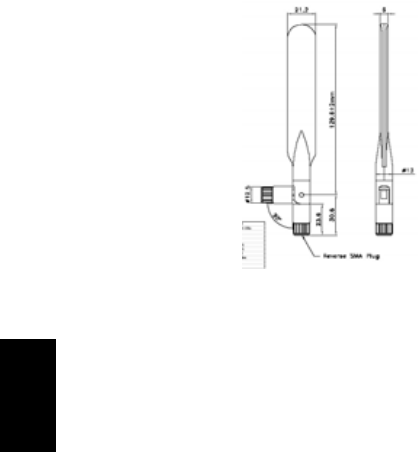LITE ON TECHNOLOGY WN2401A 802.11a/b/g mini-PCI WLAN card User Manual
LITE-ON Technology Corp. 802.11a/b/g mini-PCI WLAN card
Revised Manual

Wireless LAN 802.11a/b/g Device
1
Introduction
Your Stargate TV module functions as a Wireless Local Area
Network (WLAN) connecting with other wireless product(s)
via 802.11 technology.
802.11 technology allows over-the-air connection between
devices. Your Stargate TV module is equipped with an
802.11a/b/g product which allows fast (up to 54Mbps)
connection rates.
Installing the Wireless LAN
802.11a/b/g Device Antenna
The Wireless LAN 802.11a/b/g Device is embedded in the
Stargate TV module and needs the antenna supplied with
your Stargate TV module to be connected. Once connected,
your Stargate TV module is ready to begin functioning in
station mode (as a client) with your Wireless Local Area
Network.
Note:
It is assumed that there is an existing wireless LAN
network with an Internet connection (please consult your
ISP for further information).
Package contents consist of an antenna with a
connector located at the end (A) that screws into the
antenna jack located on the back of the Stargate TV module
(B).
A) Antenna Installation
1. Screw the antenna connector (A) to the antenna jack (B)
located on the back of the Stargate TV module.
2. Place the Stargate TV module on a table or place the
antenna in an elevated and open area to achieve the best
wireless performance.
B) Troubleshooting
Prior to contacting customer support check the following
items and reboot the Stargate TV module:
1. Verify that both the Stargate TV module as well as the
wireless broadband router/access point are powered.
2. Verify that the antenna is connected securely to the back
of your Stargate TV module.
English
Wireless LAN 802.11a/b/g Device
2
C) Customer Support
Customer support information can be obtained from System
Warranty and Support Guide.
INFORMATION TO USER
Federal Communication Commission
Interference Statement
This equipment has been tested and found to comply with the
limits for a Class B digital device, pursuant to Part 15 of the
FCC Rules. These limits are designed to provide reasonable
protection against harmful interference in a residential
installation.
This equipment generates, uses and can radiate radio
frequency energy and, if not installed and used in accordance
with the instructions, may cause harmful interference to radio
communications. However, there is no guarantee that
interference will not occur in a particular installation. If this
equipment does cause harmful interference to radio or
television reception, which can be determined by turning the
equipment off and on, the user is encouraged to try to correct
the interference by one of the following measures:
-Reorient or relocate the receiving antenna.
Wireless LAN 802.11a/b/g Device
3
-Increase the separation between the equipment and
receiver.
-Connect the equipment into an outlet on a circuit different
from that to which the receiver is connected.
-Consult the dealer or an experienced radio/TV technician for
help.
This device complies with Part 15 of the FCC Rules. Operation
is subject to the following two conditions: (1) This device may
not cause harmful interference, and (2) this device must
accept any interference received, including interference that
may cause undesired operation.
FCC Caution: Any changes or modifications not
expressly approved by the party responsible for compliance
could void the user's authority to operate this equipment.
IMPORTANT NOTE:
FCC Radiation Exposure Statement:
This equipment complies with FCC radiation exposure limits
set forth for an uncontrolled environment. This equipment
should be installed and operated with minimum distance
20cm between the radiator & your body.
This transmitter must not be co-located or operating in
conjunction with any other antenna or transmitter.
This device is intended only for OEM integrators under the
following conditions:
The transmitter module may not be co-located with any other
transmitter or antenna.
As long as conduction above is met, further transmitter test
will not be required.
However, the OEM integrator is still responsible for testing
their end-product for any additional compliance requirements
required with this module installed (for example, digital
device emissions, PC peripheral requirements, etc.).
Wireless LAN 802.11a/b/g Device
4
IMPORTANT NOTE:
In the event that these conditions can not be met (for
example certain laptop configurations or co-location with
another transmitter), then the FCC authorization is no longer
considered valid and the FCC ID can not be used on the final
product. In these circumstances, the OEM integrator will be
responsible for re-evaluating the end product (including the
transmitter) and obtaining a separate FCC authorization.
If this module will be operated in 5.15 ~ 5.25GHz frequency
range, it is restricted to indoor use only. Operation outdoors
within this band could void the user's authority to operate the
equipment.